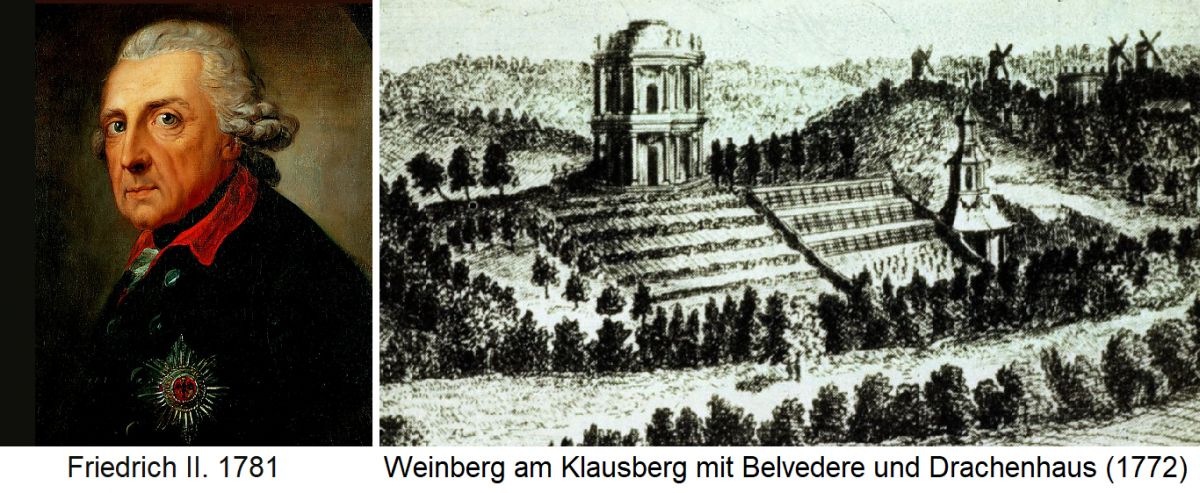The Prussian King Frederick II, posthumously "The Great" (1712-1786) was one of the greatest wine lovers of his time. He had three vineyards planted in his park in Potsdam (Brandenburg). First, on the former Wüsten Berg, were the world-famous six broad terraces of vineyards with the Sanssouci Palace, completed in 1747 and fortified with retaining walls. It was divided into six wide terraces with retaining walls and planted with foreign fruit and grape varieties. However, the yields fell short of expectations. This is also where Frederick II's final resting place is in a crypt. There is a wine cellar under the palace. To the east of this, a small vineyard known as the Winzerberg was then planted in 1763 on the former Mühlenberg. Finally, in 1769, on the southern slope of the Klausberg, which is crowned by the famous Belvedere built between 1770 and 1772, the present Royal Vineyard followed. Today, this vineyard is recultivated and run by gardeners from Mosaik-Berlin GmbH. Since 2011, wine has also been made from the grapes.

The wine cellar was built under the eastern wing of Sanssouci Palace. After 140 years of slumber, it was reopened to the public in 2004 after a seven-month restoration. In the process, the three-storey iron bottle rack was refilled with all the fine wines that were drunk at the table of Frederick II and later at the court of Frederick William IV. (1795-1861). These were local wines from the Rhine, Moselle and Saar, as well as from France, Hungary and South Africa. Frederick II's favourite wines included above all Rhine-Hessian Pinot Gris, as well as French Bergerac, Hungarian Tokay and South African Constantia.
At the Congress of Vienna in 1815, the former Electorate of Trier was annexed to the Prussian state. At the beginning of the 19th century, the royal Prussian government introduced various measures to improve the economic situation of Moselle winegrowers. These included the classification of the vineyards with the Prussian vineyard classification, the founding of the winegrowers' association and the establishment of three winegrowing domains on the Moselle and Saar. A wine duty favoured Prussian viticulture on the Mosel-Saar-Ruwer and ushered in a period of prosperity. The Moselle Riesling became immensely popular and the prices for wines from the Moselle, Saar and Ruwer clearly exceeded those of the then already famous Bordeaux.

After the end of the monarchy in 1918, the Klausberg estate fell into a slumber. In the last weeks of the Second World War, artillery fire in April 1945 caused severe damage to the buildings and the entire complex. The Belvedere was no more than a ruin and the vineyard was hardly recognisable as such. The Belvedere was restored by 2002. On the occasion of the Federal Garden Show 2001 in Potsdam, the Phoenix vine was planted below it by a Berlin school. On the initiative of the "Mosaik Workshops for the Disabled" and the "Prussian Palaces and Gardens Foundation Berlin-Brandenburg", the first 30 apple trees were planted in the Royal Vineyard in 2006. Afterwards, the Regent and Cabernet Blanc grape varieties were also planted and the first wine was pressed in 2011.
In 2014, it was decided to restore the Royal Vineyard to its former glory for its 250th anniversary in 2019. In the spirit of Frederick, not only winegrowers but all wine lovers can participate in the reconstruction. Via the website "Königlicher Weinberg" (Royal Vineyard ), one or more vines can be purchased as part of a so-called vine sponsorship. Today, more than 3,000 vines are thriving in this vineyard. Among them are 40 ancient, historic vines dating back to imperial times, which have survived the turmoil of war and decay. Among them are the varieties Black Hamburg (Muscat d'Hamburg), Agostenga and Trollinger (Schiava Grossa).
In his will, Frederick II stipulated that he should be buried in the above-mentioned tomb (without pomp, by night)("When I am there, I shall be without care"). However, his nephew and successor Frederick William II (1744-1797) had him buried in the Potsdam Garrison Church. It was not until 1991 that he received his desired final resting place.
Source: Andreas Kramp, Project Coordinator Royal Vineyard
Friedrich II: By Anton Graff - Cultural Institute, Public Domain, Link
Klausberg: By Andreas Ludwig Krüger - Drawing, Public Domain, Link
Royal Vineyard, vine sponsorship, wine from Regent: Mosaik-WfB gGmbH
Voices of our members

The wein.plus encyclopaedia is a comprehensive, well-researched reference work. Available anytime and anywhere, it has become an indispensable part of teaching, used by students and myself alike. Highly recommended!
Dominik Trick
Technischer Lehrer, staatl. geprüfter Sommelier, Hotelfachschule Heidelberg